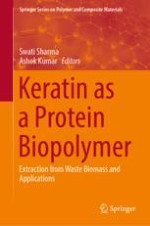This book provides information about the sources, structure, and properties of keratin as well as its applications. The extraction from different biomass sources (e.g. feathers, hairs, nails, horn, hoof, and claws) as well as the characterization methods of these extracted materials are explained. The development of bioproducts from keratins is challenging and limited since they are neither soluble in polar solvents nor in non-polar solvents. Therefore, the utilization of different microorganisms for the degradation of keratin is also discussed.
The main aim of this book is to highlight the unique features of keratin and to update readers with the possible prospects to develop various value-added products from keratins. The book is highly interesting to researchers working in industry and academia on bioproducts, tissue engineering, biocomposites, biofilm, and biofibers.
